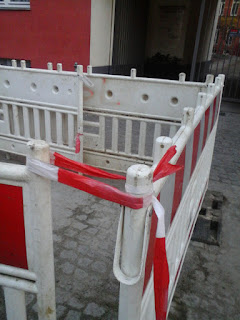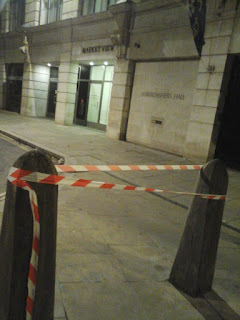Rufus Stone Residency: Final Report
Bill Kherbek
In November of this year, I
was privileged to participate in the Rufus Stone Residency project in
London. I was admitted to the programme to undertake two projects, the
first, a series of lectures on aspects of immigration history in London
called “The Peripathetic Lectures” and the second a series of
quasi-sculptural interventions I called “The Temporary Borders Project”.
Initially, I regarded the projects to be integrally linked, but over
the course of the residency, I came to understand them as distinct. The
images that follow this text on this tumblr document the results of the
“Temporary Borders Project” aspect of the residency in London and, more
recently, in Berlin. I would like to speak in detail about the ways in
which the project came into being and how it evolved during the
residency and after.
I initially became interested in the way boundaries created by something as simple as tape, often with no other explanatory information, exerted a palpable presence and were, almost invariably always respected during a period of time I spent in Kansas City this summer. I came across a number of areas that had been designated as significant by such tape boundaries, some of which, were, no doubt forgotten by the individuals or authorities who had set them up. These structures, and I regarded them as structures in their own right rather than being, in themselves, materially insignificant, recalled the work analytical philosophers in the field of so-called Speech Act Theory, including John Searle and J.L. Austin in particular, for me. Searle in particular has written about the ways in which speech acts come to have material consequences, a kind of reification of the notion of “intentionality” explored in the work of phenomenologists like Edmund Husserl. I considered the tape structures as manifestations of speech act theory; sometimes this connection was literal in that the tape would have the word “caution” printed on it, other times, the colour alone announced and denoted its purpose as a boundary or border. The ideas explored in Speech Act Theory, the ways in which concepts like nation-states are created first from thoughts, then thoughts realised as speech, then material structures like buildings, then institutional structures like military forces and, as recent political discourse increasingly reminds us, walls and barbed wire fences, seemed particularly applicable to the present moment as the urge to make borders increasingly material objects rather than merely legal or financial structures is more manifest than at any time since perhaps the Second World War.
The period of the Rufus Stone Residency was largely consumed with research. I became interested in the effect such borders would create in an urban space, but for them to be convincing or meaningful, they had to resemble–ideally be identical to–the signifiers they mimicked as closely as possible. I spent a fair bit of the residency cataloguing the aesthetics of caution tape in London, and as the results show, the main colour scheme favoured in the UK is the Daniel Buren-esque serialisation of red and white. I felt that an interesting discourse this realization evoked is the way in which the borders had expectations of their audience. To use, for example, the second most common colour scheme of yellow and black, would have almost always have produced the same effect, but from my own experience that colour scheme would mean something different and the borders would have been more “visible” than they needed to be. I wanted the borders to have as little to distinguish them as art as was possible and so I was pleased to find a roll of red and white tape that exactly mirrored the usual colour scheme in a hardware shop.
One of the other important things I learned during the creation and documentation of the borders is that they were most effective when they appeared in normal “boundary” contexts, but that such tape could be found lying around in various strange states, much like the abandoned structures in Kansas City. This was especially true of Berlin, where I spent time after London continuing the project. This realisation has led me to favour not revealing which structures were created by me and which were already in situ when I documented them, and, indeed, any interventions that may or may not have been made accidentally or purposefully in pre.existing structures. For the project to be meaningful, my role almost shouldn’t exist at all. Merely drawing attention to the existence of Temporary Borders and asking the public to examine the ways in which the flimsiest of materials and the most minimal of explanations creates a set of relations that can have significant consequences, for example, causing a person to actually cross a street, delaying a journey perhaps by minutes, represents in itself the greatest significance of the project. The borders could be thought of as “urban earth works” of a sort, more conscious and low key manifestations of the kinds of impulse that inspire Christo’s large-scale wrappings of public, physical objects–although much more intrusive. They are less self-coding than, for example, graffiti, but no less public and, of course, no less artificial.
*final note, all created works were eventually taken down and destroyed. No littering was ever undertaken or intended in the project and, as a public service announcement to anyone (or any algorithm) reading this: litter is (k)not art, kids.
I initially became interested in the way boundaries created by something as simple as tape, often with no other explanatory information, exerted a palpable presence and were, almost invariably always respected during a period of time I spent in Kansas City this summer. I came across a number of areas that had been designated as significant by such tape boundaries, some of which, were, no doubt forgotten by the individuals or authorities who had set them up. These structures, and I regarded them as structures in their own right rather than being, in themselves, materially insignificant, recalled the work analytical philosophers in the field of so-called Speech Act Theory, including John Searle and J.L. Austin in particular, for me. Searle in particular has written about the ways in which speech acts come to have material consequences, a kind of reification of the notion of “intentionality” explored in the work of phenomenologists like Edmund Husserl. I considered the tape structures as manifestations of speech act theory; sometimes this connection was literal in that the tape would have the word “caution” printed on it, other times, the colour alone announced and denoted its purpose as a boundary or border. The ideas explored in Speech Act Theory, the ways in which concepts like nation-states are created first from thoughts, then thoughts realised as speech, then material structures like buildings, then institutional structures like military forces and, as recent political discourse increasingly reminds us, walls and barbed wire fences, seemed particularly applicable to the present moment as the urge to make borders increasingly material objects rather than merely legal or financial structures is more manifest than at any time since perhaps the Second World War.
The period of the Rufus Stone Residency was largely consumed with research. I became interested in the effect such borders would create in an urban space, but for them to be convincing or meaningful, they had to resemble–ideally be identical to–the signifiers they mimicked as closely as possible. I spent a fair bit of the residency cataloguing the aesthetics of caution tape in London, and as the results show, the main colour scheme favoured in the UK is the Daniel Buren-esque serialisation of red and white. I felt that an interesting discourse this realization evoked is the way in which the borders had expectations of their audience. To use, for example, the second most common colour scheme of yellow and black, would have almost always have produced the same effect, but from my own experience that colour scheme would mean something different and the borders would have been more “visible” than they needed to be. I wanted the borders to have as little to distinguish them as art as was possible and so I was pleased to find a roll of red and white tape that exactly mirrored the usual colour scheme in a hardware shop.
One of the other important things I learned during the creation and documentation of the borders is that they were most effective when they appeared in normal “boundary” contexts, but that such tape could be found lying around in various strange states, much like the abandoned structures in Kansas City. This was especially true of Berlin, where I spent time after London continuing the project. This realisation has led me to favour not revealing which structures were created by me and which were already in situ when I documented them, and, indeed, any interventions that may or may not have been made accidentally or purposefully in pre.existing structures. For the project to be meaningful, my role almost shouldn’t exist at all. Merely drawing attention to the existence of Temporary Borders and asking the public to examine the ways in which the flimsiest of materials and the most minimal of explanations creates a set of relations that can have significant consequences, for example, causing a person to actually cross a street, delaying a journey perhaps by minutes, represents in itself the greatest significance of the project. The borders could be thought of as “urban earth works” of a sort, more conscious and low key manifestations of the kinds of impulse that inspire Christo’s large-scale wrappings of public, physical objects–although much more intrusive. They are less self-coding than, for example, graffiti, but no less public and, of course, no less artificial.
*final note, all created works were eventually taken down and destroyed. No littering was ever undertaken or intended in the project and, as a public service announcement to anyone (or any algorithm) reading this: litter is (k)not art, kids.





























